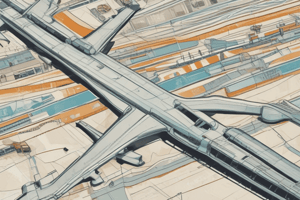Podcast
Questions and Answers
Which color are taxiway shoulder markings?
Which color are taxiway shoulder markings?
- Yellow (correct)
- Black
- Red
- White
What do surface painted taxiway direction signs look like?
What do surface painted taxiway direction signs look like?
- Blue background with a white inscription
- White background with a red inscription
- Black background with a yellow inscription
- Yellow background with a black inscription (correct)
Where are surface painted location signs located?
Where are surface painted location signs located?
- Right side of the centerline (correct)
- On the runway
- On the taxiway edge
- Left side of the centerline
What do runway holding position markings consist of?
What do runway holding position markings consist of?
What do the VOR receiver checkpoint markings consist of?
What do the VOR receiver checkpoint markings consist of?
What color are the nonmovement area boundary markings?
What color are the nonmovement area boundary markings?
What markings are placed on a runway to indicate that it is temporarily closed?
What markings are placed on a runway to indicate that it is temporarily closed?
What is the purpose of the yellow cross installed at each entrance to a temporarily closed taxiway?
What is the purpose of the yellow cross installed at each entrance to a temporarily closed taxiway?
Which type of runway marking consists of groups of one, two, and three rectangular bars symmetrically arranged in pairs about the runway centerline?
Which type of runway marking consists of groups of one, two, and three rectangular bars symmetrically arranged in pairs about the runway centerline?
What is the purpose of runway side stripes?
What is the purpose of runway side stripes?
How many threshold stripes are there for a runway width of 100 feet (30 m)?
How many threshold stripes are there for a runway width of 100 feet (30 m)?
What is a displaced threshold?
What is a displaced threshold?
Which of the following markings is used to show pavement areas aligned with the runway that are unusable for landing, takeoff, and taxiing?
Which of the following markings is used to show pavement areas aligned with the runway that are unusable for landing, takeoff, and taxiing?
What is the purpose of enhanced taxiway centerline markings?
What is the purpose of enhanced taxiway centerline markings?
According to the text, when approaching runways at airports with an operating control tower, pilots must not cross the runway holding position marking without ATC clearance. What must pilots do when approaching runways at airports without an operating control tower?
According to the text, when approaching runways at airports with an operating control tower, pilots must not cross the runway holding position marking without ATC clearance. What must pilots do when approaching runways at airports without an operating control tower?
What do runway holding position markings identify?
What do runway holding position markings identify?
When specifically instructed by ATC to hold short of the ILS critical area, what must pilots do?
When specifically instructed by ATC to hold short of the ILS critical area, what must pilots do?
What do surface painted holding position signs indicate?
What do surface painted holding position signs indicate?
Which color are the markings for areas not intended for use by aircraft (closed and hazardous areas), and holding positions (even if they are on a runway)?
Which color are the markings for areas not intended for use by aircraft (closed and hazardous areas), and holding positions (even if they are on a runway)?
Which color are the markings for runways?
Which color are the markings for runways?
What type of markings are there for runways?
What type of markings are there for runways?
Flashcards
Taxiway Shoulder Markings
Taxiway Shoulder Markings
Yellow markings on taxiway shoulders indicate the edges of usable taxiway surfaces.
Taxiway Direction Signs
Taxiway Direction Signs
Surface painted taxiway direction signs have a yellow background with black inscriptions, indicating the direction of taxiing.
Taxiway Location Signs
Taxiway Location Signs
Surface painted location signs are placed on the right side of the centerline, indicating the location of taxiways and other areas.
Runway Holding Position Markings
Runway Holding Position Markings
Signup and view all the flashcards
VOR Receiver Checkpoint Markings
VOR Receiver Checkpoint Markings
Signup and view all the flashcards
Nonmovement Area Boundary Markings
Nonmovement Area Boundary Markings
Signup and view all the flashcards
Temporary Runway or Taxiway Closure Markings
Temporary Runway or Taxiway Closure Markings
Signup and view all the flashcards
Yellow Cross at Taxiway Entrance
Yellow Cross at Taxiway Entrance
Signup and view all the flashcards
Touchdown Zone Markings
Touchdown Zone Markings
Signup and view all the flashcards
Runway Side Stripes
Runway Side Stripes
Signup and view all the flashcards
Threshold Stripes
Threshold Stripes
Signup and view all the flashcards
Displaced Threshold
Displaced Threshold
Signup and view all the flashcards
Chevron Markings
Chevron Markings
Signup and view all the flashcards
Enhanced Taxiway Centerline Markings
Enhanced Taxiway Centerline Markings
Signup and view all the flashcards
Crossing Runway Holding Position Markings
Crossing Runway Holding Position Markings
Signup and view all the flashcards
Runway Holding Position Markings
Runway Holding Position Markings
Signup and view all the flashcards
Holding Short of ILS Critical Area
Holding Short of ILS Critical Area
Signup and view all the flashcards
Surface Painted Holding Position Signs
Surface Painted Holding Position Signs
Signup and view all the flashcards
Yellow Markings
Yellow Markings
Signup and view all the flashcards
White Markings
White Markings
Signup and view all the flashcards
Runway Markings
Runway Markings
Signup and view all the flashcards




